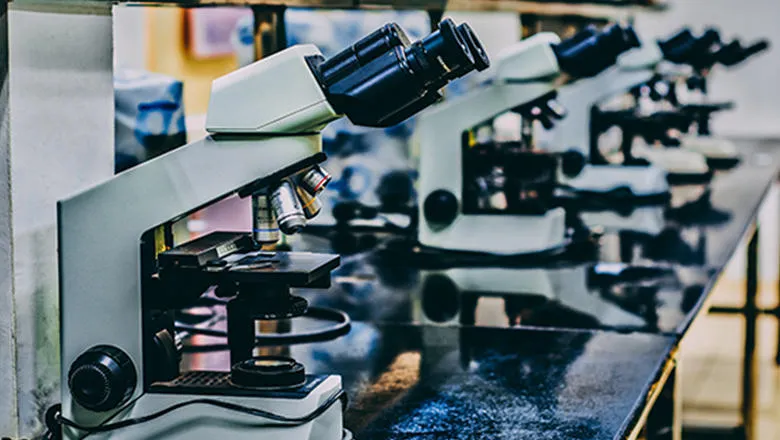23 November 2019
DNA: the life force of the planet
Following in the footsteps of Franklin and Gosling, King’s continues to lead the way at the forefront of DNA research.

[This article is from the Autumn/Winter 2019 issue of InTouch, your alumni magazine]
In 1952, the inauspiciously entitled ‘Photo 51’ was taken at King’s by Dr Rosalind Franklin and Raymond Gosling, a PhD student. ‘Photo 51’ is probably one of the best-known photographs in the history of science, as it provided confirmation of the structure of deoxyribonucleic acid (DNA) – the driving force of all life on earth. Following in the footsteps of Franklin and Gosling, King’s continues to lead the way at the forefront of DNA research.
King's Forensics
King’s Forensics sits within the Department of Analytical, Environmental & Forensic Sciences. Located in the Franklin-Wilkins Building, it is now home to three internationally accredited forensic laboratories, including laboratories such as the Drug Control Centre (Anti-Doping); the City of London Fingerprint laboratory; and the DNA laboratory (also endorsed by the Ministry of Justice).
Forensic Genetics within King’s Forensics has a wide scope, including family identification, criminal intelligence and disaster identification. In recent times, the role of DNA in forensic evidence gathering has become known through crime fiction in both books and on TV, but in science there is not ‘the world before DNA and the world after DNA’.

The science is constantly improving, with King’s at the cutting edge. A team led by Denise Syndercombe Court, who is Professor of Forensic Genetics, and Dr David Ballard (MSc Forensic Science, 2000), who is a postdoctoral researcher in the same research group at King’s, is developing the use of massively parallel sequencing (MPS), which allows forensic scientists to bring even degraded or limited DNA samples to the standards required for criminal investigations. MPS technology allows a greater number of genetic markers to be analysed and with that comes increased sensitivity and therefore enhanced credibility.
Fighting crime
The Forensic Genetics group is developing a series of methods to provide accurate chronological age from small blood samples. The group working on this has established a limited series of age-related markers leading to the development of an artificial intelligence-driven model that can identify the age of an individual from blood samples left at a crime scene. The group is now researching other markers that could make the process even more accurate.

Dr Ballard told us:
'If you find a blood spot at a crime scene and you don’t know who the perpetrator is, the one thing we can tell you now is that, even though your DNA sequence doesn’t change across your life, there are various modifications to it over the years. We now have an error rate of about three years, on average, of being able to predict how old someone was just from a spot of blood.'
Taking technology into the wild
A team led by Dr Leon Barron, a forensic scientist within King’s Forensics, has also developed new technology (in partnership with the Metropolitan Police Service) to detect fingerprints left by poachers on elephant tusks.

Dr Barron told us: ‘Traditional technology can already do this, but it has to be done within two days. By using microscale powders, much more comprehensive detail is possible and, crucially, tests can be run up to 28 days after tusks are recovered.’ This breakthrough has been successfully integrated with the DNA profiling work being led by Professor Syndercombe Court as, using advanced techniques, DNA can be extracted from the fingerprints left on the tusks. Arrests have already been made using these methods. The fingerprint technology is now being applied to pangolin scales and rhino horns and it is expected that, in the future, it will be applied to tiger claws, sperm whales and hippo teeth. The City of London Police is now working with wildlife crime units in Africa to develop fingerprint databases of those involved in, or believed to be involved in, wildlife crime.'
The next big discovery
Professor Syndercombe Court is clearly excited by the work being carried out at King’s: ‘We are doing things that most laboratories cannot do. Even today, there are many new developments in the DNA pipeline. One of those is looking at how to differentiate between primary and secondary DNA. If someone touches you, say by shaking hands, and they then go on to touch something at what becomes a crime scene, it could be that your DNA has been picked up by the other person and is then found at that crime scene even if you had never been there. Being able to identify and therefore eliminate secondary DNA from a crime scene would be immensely important.
GLAD to investigate anxiety and depression
Depression and anxiety are the most common mental health disorders across the world and estimates suggest one in three people in the UK will experience symptoms during their life. Worse, current treatments are not effective and about 50% of those getting treatment will not recover.

The Genetic Links to Anxiety and Depression (GLAD) study, funded by the National Institute for Health Research and led by Professor Gerome Breen and Professor Thalia Eley, at the Institute of Psychiatry, Psychology & Neuroscience at King’s, is a groundbreaking research project. By studying both genes and environmental factors, the study will produce novel results to help our understanding of the conditions and improve treatments. Using psychological data (from patients’ questionnaires) and biological data (from their DNA samples), as well as linking data with patients’ medical records (with their fully informed consent), the study will be able to look at any patterns of severity of conditions, recovery and whether genetics impacts them.
Professor Breen told InTouch:
Previous work has indicated that about 30–40% of the risk for both depression and anxiety is genetic, with environment accounting for the remainder. So, while genetics is not the biggest risk factor, it is important we investigate it alongside the environment. GLAD is designed to be the largest re-contactable study group for mental health, aiming to recruit 40,000 people to the study, and we hope to enable a new wave of interconnected studies and clinical trials into anxiety and depression.
Putting the pieces together
The areas highlighted in this article are just a small part of the innovative work King’s is involved in. The understanding of the uses of DNA in a wide variety of fields will continue to develop and King’s will remain a leading player in the race for ever-greater knowledge.
